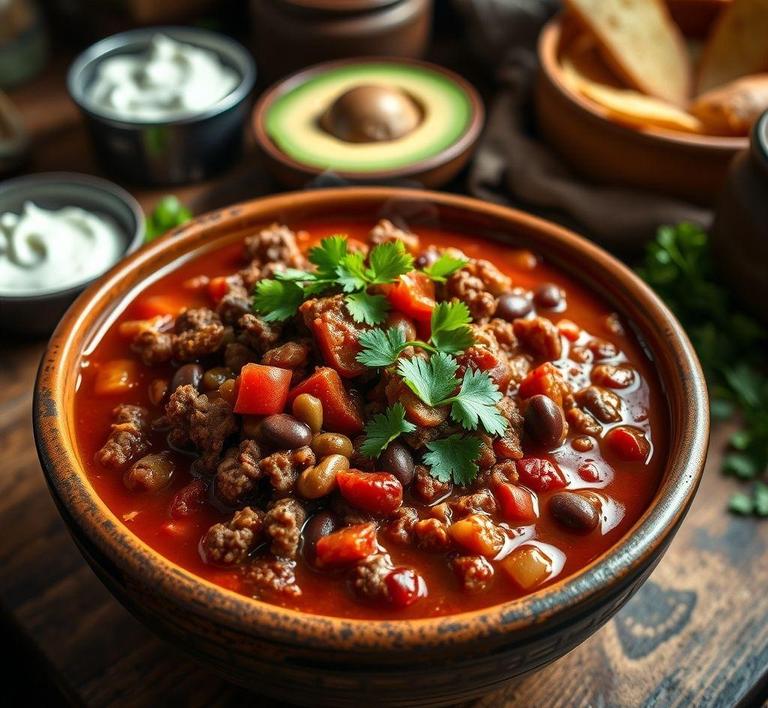If you’ve found yourself with leftover chilli con carne and are wondering whether it’s safe to refreeze, you’re not alone! Refreezing this hearty dish is possible, but there are a few important steps to follow to ensure it remains delicious and safe to eat later. Chilli con carne, with its mix of meat, beans, and spices, can be a bit tricky when it comes to refreezing, as the texture and flavor can sometimes change. But with the right handling and proper storage, you can enjoy your chilli con carne just as much the second time around. Let’s dive into everything you need to know to safely refreeze your chilli con carne and keep it tasting amazing!
Can You Refreeze Chilli Con Carne?

Refreezing food is a topic that often raises questions, especially when it comes to hearty, meaty dishes like Chilli Con Carne. If you’ve ever found yourself with leftover chili, you might have wondered if it’s safe to refreeze it or whether you’ll ruin the flavor and texture in the process.
In theory, you can refreeze Chilli Con Carne, but there are a few things to consider. The most important factor is the way the chili was handled initially. For safety and quality, the chili must have been thawed properly and stored under the right conditions after its initial freeze. Here’s the key point: food should only be refrozen if it’s been defrosted in the refrigerator (not at room temperature). This ensures that bacteria haven’t had the chance to multiply, which could pose a health risk when reheating.
Additionally, while it’s technically possible to refreeze Chilli Con Carne, it’s not always the best idea when it comes to maintaining its taste and texture. Meat, beans, and vegetables in chili tend to break down during the freezing and thawing process, so after refreezing, the dish may lose some of its original integrity.
How To Refreeze Chilli Con Carne?
If you’ve determined that it’s safe to refreeze your Chilli Con Carne, follow these steps to ensure that the process is done as safely and effectively as possible:
- Thaw Properly: Before considering refreezing, make sure the chili has been thawed safely. Ideally, it should have been defrosted in the fridge, not on the countertop. If you thaw chili at room temperature, bacteria can grow rapidly and could cause foodborne illnesses.
- Evaluate the Quality: After thawing, give your chili a taste and check for any signs of spoilage, like a sour odor, discoloration, or a strange texture. If the chili looks or smells off, it’s best to discard it rather than risk food poisoning.
- Store in Small Portions: If you plan to refreeze your chili, it’s a good idea to break it down into smaller portions. This way, you can thaw only what you need and avoid refreezing more than once. Use airtight containers or heavy-duty freezer bags to prevent freezer burn.
- Cool the Chili Before Refreezing: If you’re working with freshly reheated chili (after thawing), make sure it has cooled down to room temperature before storing it back in the freezer. Freezing hot food can raise the temperature inside the freezer, potentially putting other frozen items at risk.
- Label Your Containers: Make sure to label each portion with the date it was originally made and when it was refrozen. This will help you track how long the chili has been frozen, and ensure it’s used within a reasonable timeframe.
- Reheat Safely: When you’re ready to eat your refrozen chili, make sure it’s reheated thoroughly. Heat it to a rolling boil to kill any potential bacteria. Avoid reheating multiple times, as doing so will further degrade the quality and texture.
Quality Impact
While the safety of refreezing chili is a critical concern, the quality impact is often what disappoints many. Let’s dive deeper into what happens to your Chilli Con Carne when it goes through the freezing and refreezing process:
- Meat Texture: When chili is frozen, the water in the meat (and other ingredients) expands, causing the cell walls of the meat to break down. Upon thawing and refreezing, this breakdown occurs again, leading to a mushier texture. The beef or ground turkey in your chili might become a bit gristly or dry, losing some of the tenderness and juiciness you originally enjoyed.
- Beans: Beans, a staple in Chilli Con Carne, don’t hold up as well to freezing and refreezing as other ingredients. They can become soft, mushy, and waterlogged, making them less pleasant to bite into. When thawed and refrozen, beans also tend to absorb too much liquid, resulting in a soupy or unappealing consistency.
- Vegetables: Like beans, vegetables such as bell peppers, onions, and tomatoes undergo cellular breakdown when frozen and refrozen. This can lead to an unpleasant mushiness that compromises both the texture and appearance of the dish. Tomatoes, in particular, lose their freshness and flavor after freezing.
- Flavor Loss: Freezing (and refreezing) may cause some of the spices and herbs to dissipate, leading to a loss of depth and richness in flavor. The longer the chili sits in the freezer, the more its spices tend to mellow out. This can result in a less vibrant, more flat-tasting dish once it’s reheated.
- Freezer Burn: Freezer burn occurs when air reaches the surface of the food, leading to dehydration and the formation of ice crystals. It can make the surface of your chili look unappetizing and can lead to off-flavors. If your chili is not stored properly, it can get freezer burn even if refrozen once, making it unpalatable.
While you can refreeze Chilli Con Carne, it’s something that should be approached with caution. The safety aspect is relatively straightforward if you follow proper thawing and refreezing procedures. However, when it comes to the quality of the dish, refreezing chili can significantly impact the texture, flavor, and overall appeal.
If you find yourself with leftover chili, consider dividing it into smaller portions and only refreezing what you won’t finish within a few days. If you’re hoping for the best texture and flavor when reheating, it’s wise to limit the number of times the chili is frozen and thawed. For a better outcome, you could also try to freshen it up with added spices or fresh ingredients upon reheating to compensate for some of the flavor loss.
Is It Safe To Refreeze Chilli Con Carne?
Refreezing chili con carne-much like any cooked food-can be safe, but it comes with several important considerations. Chili, which is typically made from ground meat, beans, tomatoes, spices, and sometimes vegetables, is a dish that often gets prepared in large batches, making it a frequent candidate for freezing. However, the safety of refreezing chili con carne depends on how it was originally frozen, how long it’s been thawed, and how carefully you handle the process.
The general rule is that as long as chili con carne has been thawed correctly in the refrigerator and has not spent an excessive amount of time in the "danger zone" (between 40°F – 140°F or 4°C – 60°C), it can be refrozen without any significant health risks. However, it’s crucial that the chili has been kept at a safe temperature during the initial freezing, thawing, and refreezing process. As soon as the chili begins to warm up and stays at room temperature for an extended period, harmful bacteria can begin to multiply. Refreezing it in such a case can further contribute to bacterial growth and pose a health risk.
Moreover, the texture and flavor of the chili may deteriorate with each freeze and thaw cycle, as the ice crystals that form during freezing can break down the food’s cellular structure. This can lead to a soggy or mushy texture, particularly with the beans or ground meat, although the chili will still be safe to eat if stored properly.
Signs That Chilli Con Carne Should Not Be Refrozen
While refreezing chili con carne can be safe when done correctly, there are certain signs that should prompt you to discard it rather than attempt to refreeze. Here are some clear indicators that chili con carne should not be refrozen:
- Unpleasant Odor: If the chili smells sour, rancid, or off in any way, this is a clear sign that bacteria have likely begun to grow. This can happen if the chili has been left at an unsafe temperature for too long. Any unusual smell means it’s best to throw the chili out rather than risk food poisoning.
- Discoloration: After thawing, chili should maintain its normal deep red or brownish hue. If you notice any strange discoloration, like green or gray patches, this is another red flag. It’s a sign that bacteria have started to break down the food, making it unsafe for consumption or refreezing.
- Visible Mold or Sliminess: Mold growth is a clear sign that the chili has been exposed to contaminants and is no longer safe to eat. Similarly, if the chili has developed a slimy texture or feels sticky, it’s a good indication of bacterial or fungal activity, and refreezing will not make it safe to eat.
- Been Left at Room Temperature Too Long: If the chili has been left out for more than 2 hours at room temperature (or 1 hour if the temperature is above 90°F or 32°C), it’s unsafe to refreeze. Bacteria thrive in this “danger zone”, and refreezing won’t eliminate the risk of foodborne illness.
- Excessive Ice Crystals or Freezer Burn: While not necessarily unsafe, an excessive amount of ice crystals or freezer burn indicates that the chili has been in the freezer for a prolonged period and may have suffered a degradation in quality. If it appears dried out or discolored due to freezer burn, the chili will likely be less appetizing after refreezing.
Common Refreezing Mistakes
Refreezing chili con carne, or any food, is a delicate process, and there are a few common mistakes people tend to make. Avoiding these mistakes can help you maintain both the safety and quality of your chili.
- Not Thawing Properly: One of the biggest mistakes people make is thawing chili improperly before refreezing it. The correct method is to thaw chili in the refrigerator, not on the countertop. Thawing it at room temperature can allow the chili to enter the danger zone for too long, encouraging bacterial growth. Quick-thawing methods, such as using a microwave, can also cause uneven heating, where some parts of the chili may reach unsafe temperatures.
- Refreezing After Extended Thawing: If chili has been sitting out for more than 2 hours, refreezing it is a no-go. This is because the bacteria that might have started growing during that time won’t be killed just by freezing it again. If you’re unsure how long it’s been thawed, it’s safer to discard it rather than risk foodborne illness.
- Freezing Multiple Times: While it’s safe to refreeze chili once, doing so multiple times can significantly affect its quality and safety. Repeated freezing and thawing cycles degrade the texture and flavor of the food. It also increases the risk of bacteria surviving and multiplying, as some might survive the freezing process and rapidly multiply after thawing.
- Using Subpar Storage Methods: Not properly packaging your chili before freezing it can cause it to lose moisture and degrade in quality. If you don’t seal the chili in an airtight container or freezer-safe bag, air can enter and cause freezer burn, which leads to a mushy texture and loss of flavor.
- Refreezing Large Portions: While freezing chili in large portions might seem convenient, it’s better to freeze smaller portions. This helps you thaw only what you need, reducing the risk of re-freezing leftovers. Large batches, when thawed, can take longer to reheat safely and can be difficult to divide without cross-contaminating.
Tips And Tricks
To help you refreeze chili con carne safely and preserve its quality, here are some helpful tips and tricks:
- Freeze in Small Portions: Divide your chili into smaller portions before freezing it. This not only makes it easier to thaw only what you need, but it also helps the chili freeze more quickly and evenly. You can use freezer-safe bags or containers for this purpose.
- Cool Chili Before Freezing: Allow your chili to cool completely before freezing. If you try to freeze hot chili, the condensation inside the storage container can create ice crystals that will compromise the texture and flavor when it’s thawed.
- Label and Date Containers: Always label your containers with the date you froze the chili. This ensures you can track how long it’s been in the freezer and avoid keeping it for too long.
- Freeze in Layers: If you’re freezing multiple servings in one container, layer the chili rather than just dumping it all in at once. This allows for quicker freezing and more uniform freezing, which helps maintain quality.
- Use Proper Thawing Techniques: Always thaw chili in the fridge rather than on the counter. This maintains its safety and prevents bacteria from multiplying. If you need to thaw it quickly, use the microwave on a defrost setting, but be sure to reheat it thoroughly before eating.
- Avoid Refreezing After Long Storage: If chili has been sitting in the fridge for several days, it’s best to reheat and eat it rather than refreezing it. The longer it sits, the more likely harmful bacteria are to develop, even if it’s been stored correctly.
Conclusion
Refreezing chili con carne is certainly possible and can be done safely as long as you follow the proper guidelines. The key factors to ensure safety are maintaining the right temperatures during the freezing and thawing processes and avoiding refreezing chili that has been left at room temperature for too long. By being mindful of these factors and taking steps to preserve the quality of your chili-such as freezing it in smaller portions, labeling containers, and avoiding excessive refreezing-you can enjoy your homemade chili at a later date without compromising its safety or taste. Ultimately, while refreezing chili is a great way to reduce waste and extend its shelf life, it’s important to always check for signs of spoilage and handle the chili with care.


